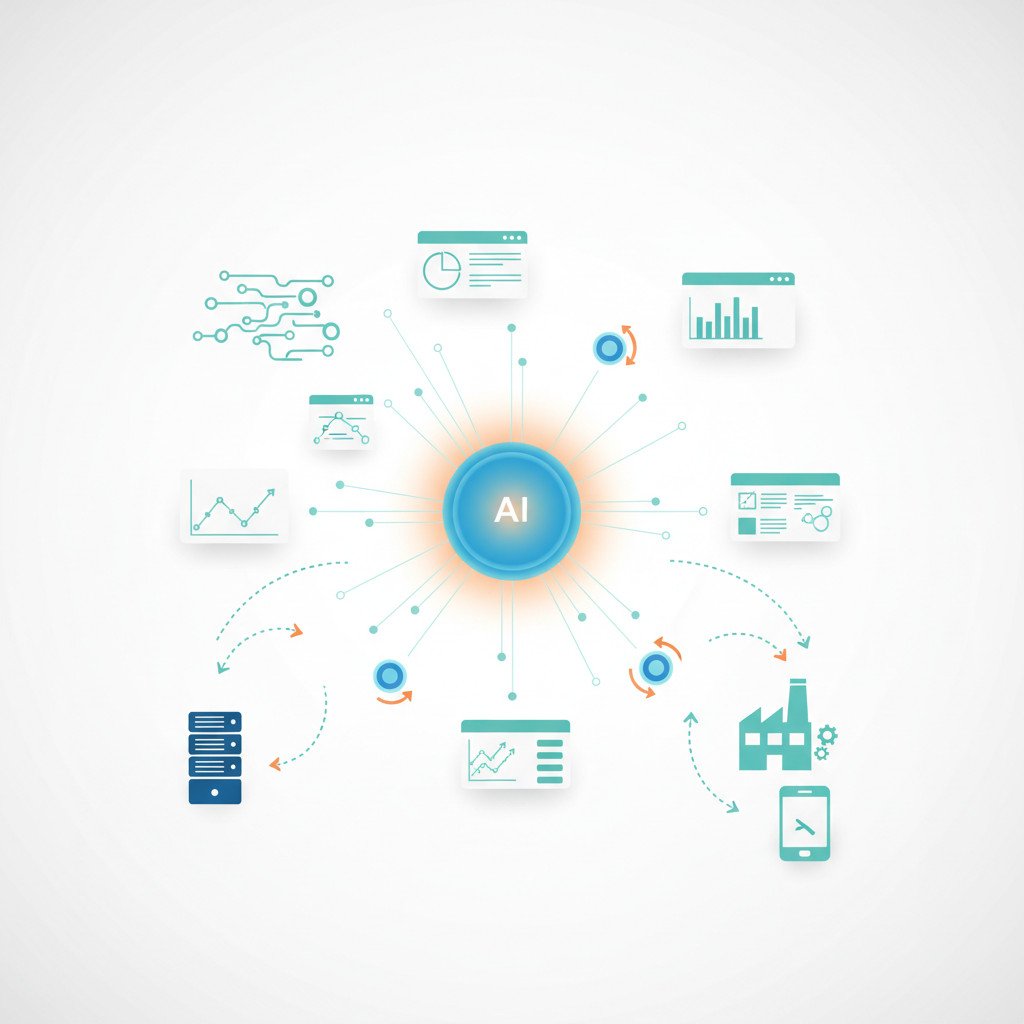Imagine dashboards that not only show trends but also act autonomously to fix problems. AI-powered analytics and agentic AI platforms are making that possible today. They combine real-time data, natural-language querying, and autonomous agents to surface insights faster. As a result, teams spot churn risks and optimize workflows in hours instead of weeks. Because these systems learn from telemetry and historical patterns, they scale decisions across products and operations. They also reduce reliance on tribal knowledge and manual reporting. For businesses, that means faster go-to-market cycles and higher operational resilience.
However, adoption requires clear guardrails around governance and explainability. Therefore, product leaders must balance bold experimentation with robust controls. This article explores commercial openings at the intersection of analytics, large models, and agentic systems. We focus on vibe analytics, real-time KPI dashboards, agentic orchestration, and developer tooling. As a result, you will learn where startups can create value and how enterprises can capture it. Read on to discover practical startup ideas, technical levers, and market signals that matter now.
AI-powered analytics and agentic AI platforms: what they are
AI-powered analytics and agentic AI platforms combine advanced machine learning, large language models, and automated agents to turn raw data into actionable decisions. In practice, these systems ingest telemetry, event streams, and historical records. Then they apply statistical modeling and pretrained models to detect patterns, anomalies, and trends. Because they support natural-language querying and explainable outputs, semitechnical users can ask questions and get clear answers. For context on how analytics fits broader decision workflows, see business intelligence resources such as Wikipedia’s Business Intelligence overview.
How agentic AI platforms enable automation and smarter business intelligence
Agentic AI platforms extend analytics by adding autonomous actions. Rather than only flagging a problem, an agent can propose a fix, run an experiment, or trigger a rollback. Therefore teams close the loop faster. These platforms orchestrate multiple tools, pipelines, and APIs. As a result, they scale decisions across products and operations. For manufacturing and supply chain contexts, agentic orchestration shows clear gains in throughput and resilience. Learn more about practical agentic orchestration use cases.
Key benefits of AI-powered analytics and agentic AI platforms
- Faster insight to action: real-time dashboards, cohort analyses, and A/B readouts reduce lead time from insight to decision. As a result, teams iterate faster.
- Reduced human toil: automation handles routine data triage and root-cause checks, freeing experts for strategic work.
- Improved accuracy and prediction: models reveal subtle correlations in telemetry and IoT streams, increasing forecast fidelity.
- Scalable governance: platforms centralize policies, audit logs, and explainability layers, therefore supporting compliance.
- Developer productivity: toolchains and intelligent automation improve developer workflows and CI/CD for model-driven features; see developer automation trends for examples.
Because enterprises demand speed and control, AI-powered analytics and agentic AI platforms now sit at the core of modern product stacks. Moreover, startups can build differentiated value by pairing transparent analytics with safe autonomous actions.

Comparative table of agentic AI platforms and key features
| Platform Name | Key Capabilities | Unique Features | Ideal Use Cases |
|---|---|---|---|
| LangChain | Orchestration of LLM chains, tool integration, prompt templates | Modular connectors to APIs and vector stores; strong developer ecosystem | Prototyping agentic workflows, data retrieval augmented generation, analytics automations |
| AutoGPT | Autonomous task chaining, memory persistence, goal-driven execution | End-to-end autonomous agent patterns for multi-step goals | Proofs of concept for task automation, small-scale autonomous assistants |
| Microsoft Azure AI Agents | Enterprise orchestration, secure API routing, integration with Power Platform | Native integrations with Azure services and Power Automate; enterprise governance tooling | Large enterprises needing secure, governed autonomous actions and business process automation |
| Google Vertex AI Agents | Integrated agent tooling, multimodal model support, managed deployments | Built-in data connectors and telemetry; easy scaling on Google Cloud infrastructure | Customer support automation, analytics-driven recommendations at scale |
| Anthropic Agents (Claude tools) | Safety-focused agent behaviors, instruction following, tool use | Emphasis on controllability and safer agent policies | Domains requiring higher safety and human oversight, like finance and healthcare |
| Hugging Face Agent Tooling | Open-source agent frameworks, model hub connectivity, community models | Rapid experimentation with models from the Hub and transparent model cards | Startups and research teams building custom agentic analytics prototypes |
Key takeaways
- These platforms vary by maturity, governance, and enterprise readiness. Therefore choose based on scale and compliance needs.
- For developer-first experimentation pick modular frameworks like LangChain or Hugging Face. As a result, teams iterate faster.
- For production, enterprise-grade offerings from Microsoft or Google provide stronger governance and integrations. Because compliance matters, these platforms can simplify audits.
Further reading
- For agentic orchestration examples in manufacturing and supply chains, see Agentic Orchestration in Industry 4.0.
- For perspective on AI value and fixes that matter, see AI Value and Fixes That Matter.
- For developer automation trends and tools, see Developer Automation Trends and Tools.
Real-world applications of AI-powered analytics and agentic AI platforms
AI-powered analytics and agentic AI platforms move insights into automated action. In sales and marketing, these systems personalize campaigns and optimize funnel steps in real time. For example, analytics can score leads continuously. Then autonomous agents route high-value prospects to sales reps or trigger targeted outreach. As a result, conversion rates rise while cost per acquisition falls.
Case study highlights
- Smartcom on Huawei Versatile platform: Smartcom built a travel agent that completes bookings in under two minutes. Moreover, the agent resolved 80 percent of customer issues in three interactions. Therefore the company cut support costs and improved time-to-booking.
- Conch Group cement-model: A predictive model estimates clinker strength at three and 28 days. Because predictions deviate by less than one MPa, teams optimize calcination. As a result, Conch reduced coal use and improved production efficiency.
- Fabi and vibe analytics: Generative BI platforms enable natural-language Q&A, cohort exploration, and shareable readouts. Thus product teams uncover churn drivers and feature opportunities faster. Consequently, businesses shorten experiment cycles and improve product-market fit.
- Public sector and cultural tourism: Municipal deployments use agentic pipelines to aggregate visitor telemetry, schedule events, and personalize visitor journeys. Therefore tourism agencies boost engagement with automated recommendations and curated itineraries.
Practical impacts on business outcomes
- Efficiency gains: Automation reduces manual triage and incident resolution time. As a result, teams spend less time on routine tasks.
- Revenue acceleration: Personalized recommendations and faster lead handling increase average order value and conversion rates. Therefore top-line growth follows.
- Better experimentation: Agentic platforms run hypothesis tests and apply rollbacks safely. Consequently, product teams deploy with confidence and learn faster.
- Risk reduction and compliance: Centralized policies and audit trails provide governance. Therefore enterprises can scale autonomous actions while preserving control.
These cases show that AI-powered analytics and agentic AI platforms deliver measurable ROI. However, success depends on clear goals, robust data, and governance. Therefore teams should pair bold pilots with conservative safety nets.
To summarize, AI-powered analytics and agentic AI platforms transform data into automated business outcomes. They accelerate insight to action and reduce manual toil across sales, marketing, and operations. For example, automated lead scoring, real-time recommendations, and autonomous incident mitigation drive measurable ROI.
However, firms must pair pilots with strong governance and clear metrics. EMP0, a US-based company, helps businesses adopt these technologies safely and quickly. They focus on sales and marketing automation while delivering full-stack AI and automation services. Therefore EMP0 builds integrations, analytics pipelines, and agentic workflows that map to revenue goals.
Their approach combines model engineering, product design, and production-grade orchestration for reliable delivery. As a result, teams shorten sales cycles, increase personalization, and scale repeatable growth processes.
If you want to learn more, explore EMP0’s website, blog, and creator profiles to see demos. Visit emp0.com or read case studies on articles.emp0.com to explore solutions. Follow the Twitter handle @Emp0_com and the creator profile on n8n for hands-on examples. Also read longer essays under Medium user jharilela.
Frequently asked questions about AI-powered analytics and agentic AI platforms
What are AI-powered analytics and agentic AI platforms?
AI-powered analytics use machine learning and large models to extract insights from data. Agentic AI platforms add autonomous agents that act on insights. As a result, teams move from reporting to action. In short, these systems combine real-time dashboards, natural-language querying, and automated workflows.
How do they improve sales, marketing, and revenue?
They automate lead scoring and personalize outreach at scale. For example, agents route high-value leads to reps. Therefore conversion rates improve and cost per acquisition drops. Moreover, analytics-driven recommendations increase average order value and customer lifetime value.
What risks should businesses plan for and how do they mitigate them?
Governance, bias, and explainability are primary risks. However, firms can mitigate these with audit logs, human-in-the-loop controls, and model explainability layers. Also, start with scoped pilots and rollback plans to reduce operational risk.
Can small and mid-size companies adopt these platforms?
Yes. Startups and SMBs can begin with lightweight pilots and open-source stacks. Because modular tools like vector stores and LangChain prototypes exist, teams can test fast. Then scale to production with stronger governance and cloud integrations.
How do I choose the right platform or vendor?
Choose based on scale, compliance requirements, and integrations. For instance, prefer enterprise vendors for strict governance. Conversely, pick modular frameworks for rapid experiments. Finally, evaluate developer experience, telemetry support, and cost to value.
If you want to dive deeper, return to the use cases and platform comparison sections for practical next steps.

